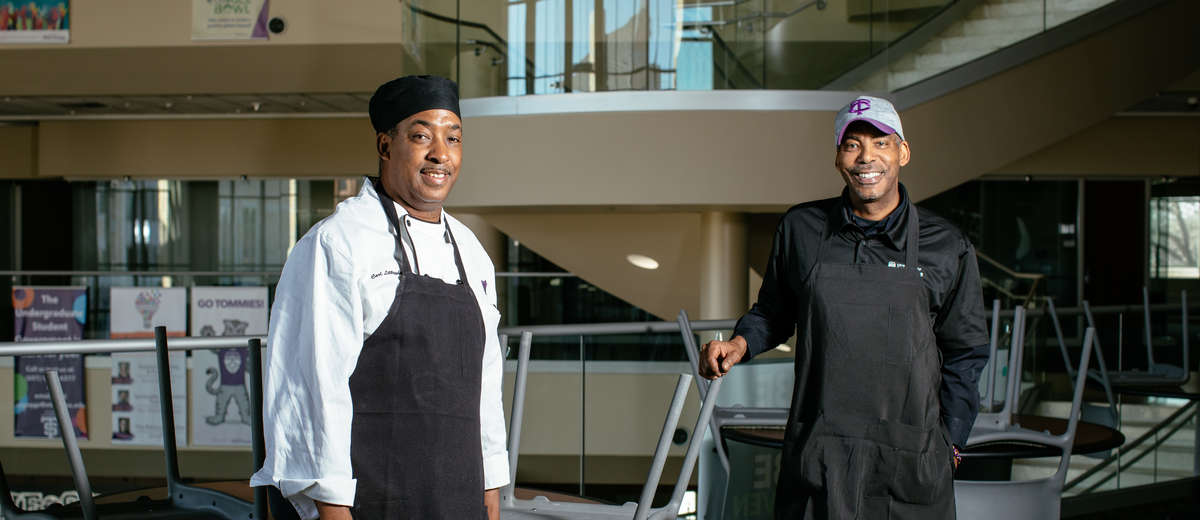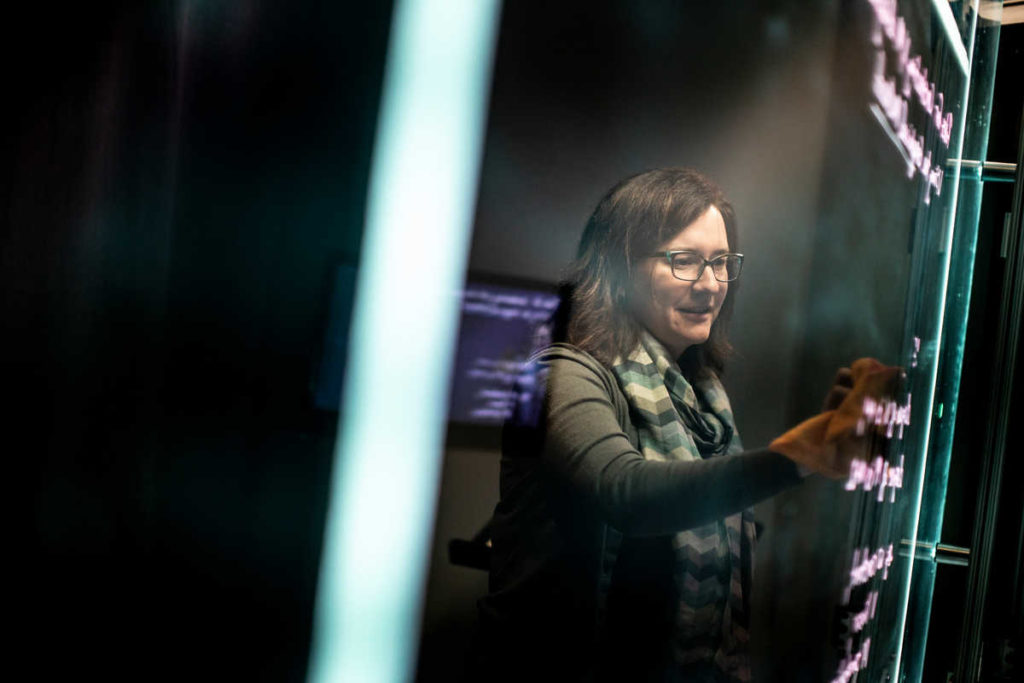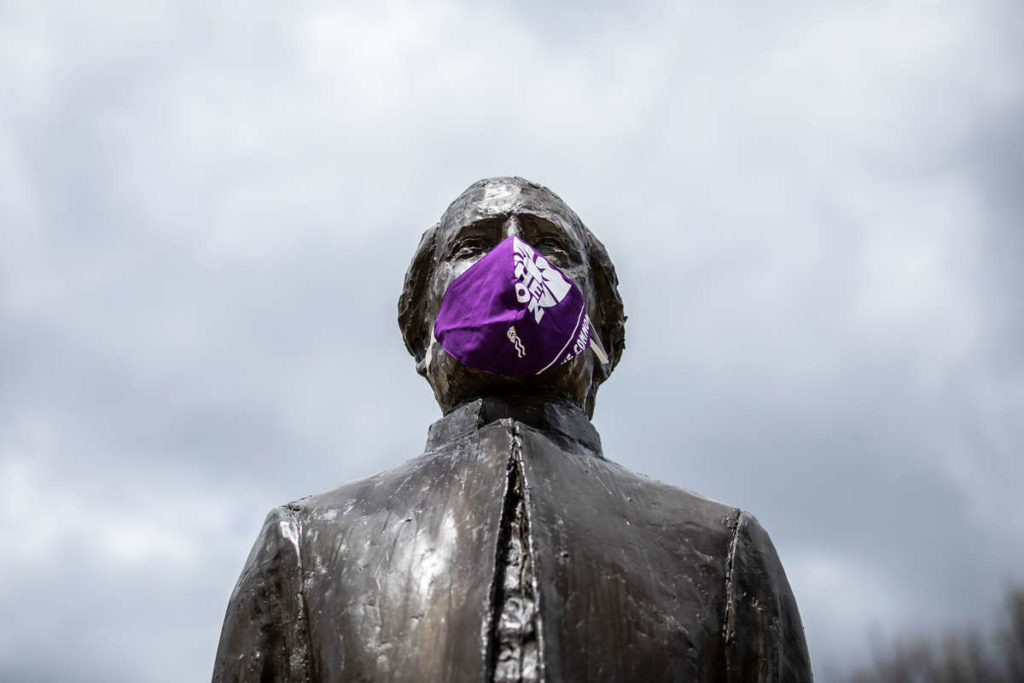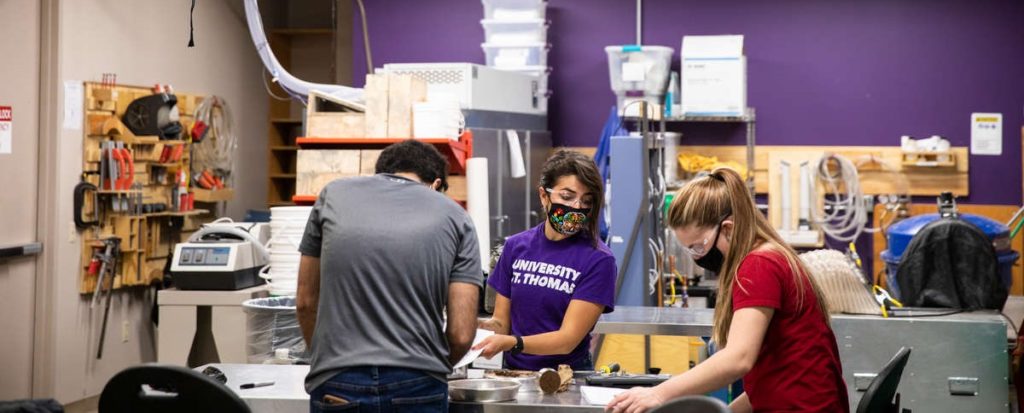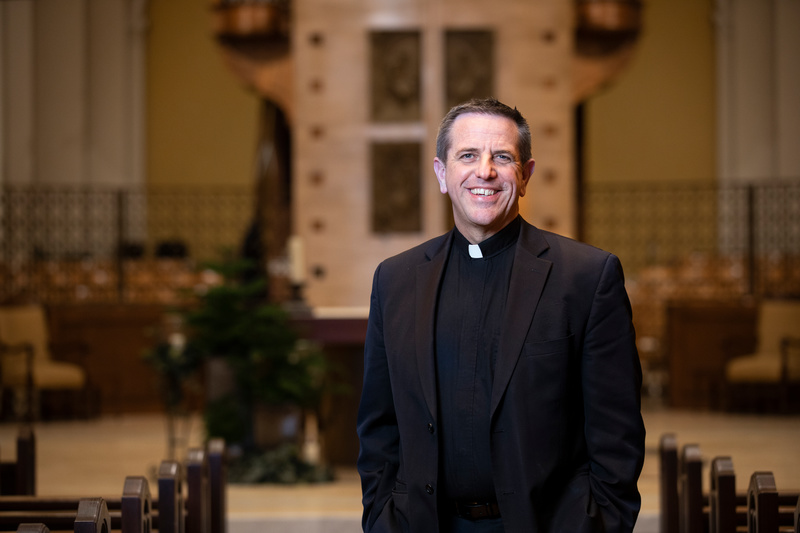Life on St. Thomas’ St. Paul and Minneapolis campuses looks more different lately than it ever has before. In response to the impact of COVID-19, campuses that are usually home and work to thousands of students, faculty and staff are much emptier these days.
They are far, however, from empty: Some 125 students continue to live in St. Paul residence halls, and dozens of essential staff continue to work in both St. Paul and Minneapolis. The Newsroom spoke with students and staff from Residence Life, Dining Services and Public Safety – and director of photography Mark Brown captured images – to give a glimpse into what life on campus currently looks like at St. Thomas.
Far from home
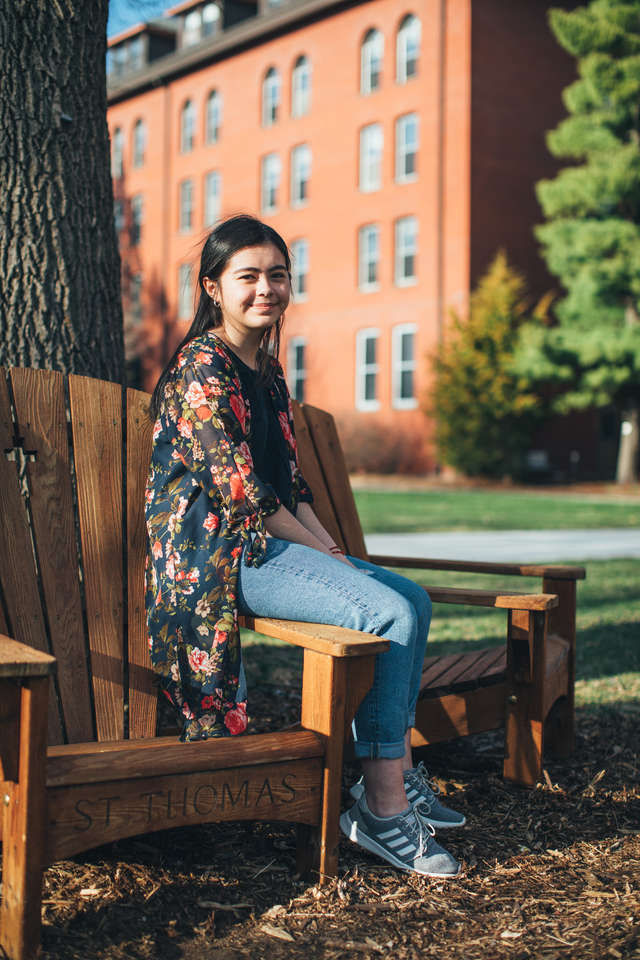
Alejandra Galo
Alejandra Galo is a first-year student from Honduras who was drawn to St. Thomas for its actuarial science program. She’s wanted to study abroad since sixth grade, although she never imagined her travels would include a global pandemic.
When it came time to deciding if she would go home or stay on campus, Galo weighed her options. She wanted to finish the semester and if she went back to her family in Honduras, finding a place to study with reliable WiFi would be a challenge. Now her country has closed its borders until further notice. She worries about loved ones back home, especially those with compromised immune systems.
Galo moved from Grace Hall to Morrison Hall where she has an apartment to herself. While she said it’s been lonely on campus, she visits with friends through Zoom. She’s appreciative of the support from the St. Thomas community, especially the Dining Services folks she sees when picking up her meals at T’s.
“Every time I pick up my food, they're so happy and supportive,” Galo said. “They always say, ‘How are you doing?’ It’s nice to have someone you can talk to. They're energetic and happy to see you. That feels good.”
Remaining on campus
Galo is one of approximately 125 students granted an exemption to stay in the residence halls because they couldn’t return home for various reasons. Some had to move to a new building – a majority are now living in Flynn and Morrison halls.
Aaron Macke, associate dean of students and director of Residence Life, acknowledged the situation is hard for students, but those on campus are doing a good job following social distancing guidelines and not gathering. Students can be outside, but they’re only allowed in their residence hall and to swipe into the Anderson Student Center to pick up prepackaged meals from T’s.
“Residence Life is continuing to serve the needs of students remaining on campus, which includes a learning outcomes approach to living on campus: holding virtual one-on-one meetings; holding virtual community meetings; sharing important information about COVID-19, how to be safe and live healthy; and hosting online events,” he said. “The Division of Student Affairs is providing online opportunities for all students to further their learning and engagement.”
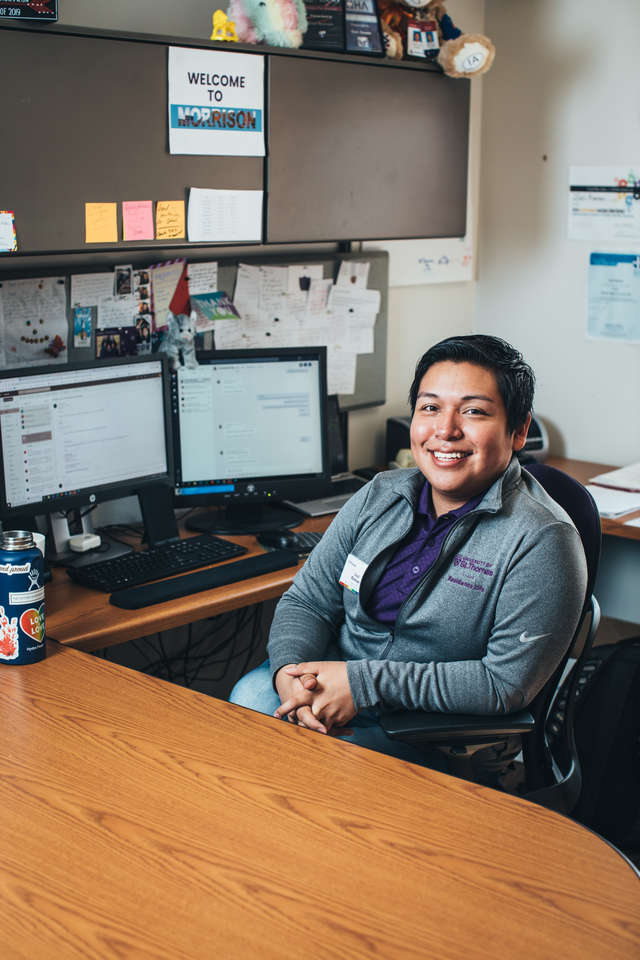
Saúl Roman
Saúl Roman, Morrison Hall director and a graduate student in leadership and student affairs, said his position requires him to wear many hats in order to be a
versatile leader. At the beginning, he said, developments and communications were coming fast so he spent much of his time making sure students had the latest information. When students relocated to Morrison, Roman posted welcome letters on their refrigerators and followed up with emails regarding virtual group meet-ups and updates on happenings including Monday motivations and information on Tommie Shelf events.
As things have calmed down, he said there’s more room to breathe and think about the current needs of students.
“It's been a challenge to be innovative with Zoom, but we’re using the platform to do more events like bingo nights and movie watch parties,” Roman said. “Some people are even doing step-by-step painting instruction. This has been really a call for creativity, especially when it comes to students’ needs.”
Being away from home
Nicolas Lovichi is a Fulbright Scholar and teaching assistant from France living in Morrison Hall. He said there is a strong international community at St. Thomas, and it was hard to see many of his friends – including his roommates – leave campus.
“At first you have really discouraging moments where you don’t realize what’s happening,” Lovichi said. “The first weeks were hard. Going back to work on Zoom and everything is helping me get through – I'm getting better.
“Given the situation in [France], I’m happy to stay here because in France you can’t go out at all – it's a complete lockdown,” he continued. “Here I feel a bit freer – I can walk on campus and get outside. I’m relieved about that.”
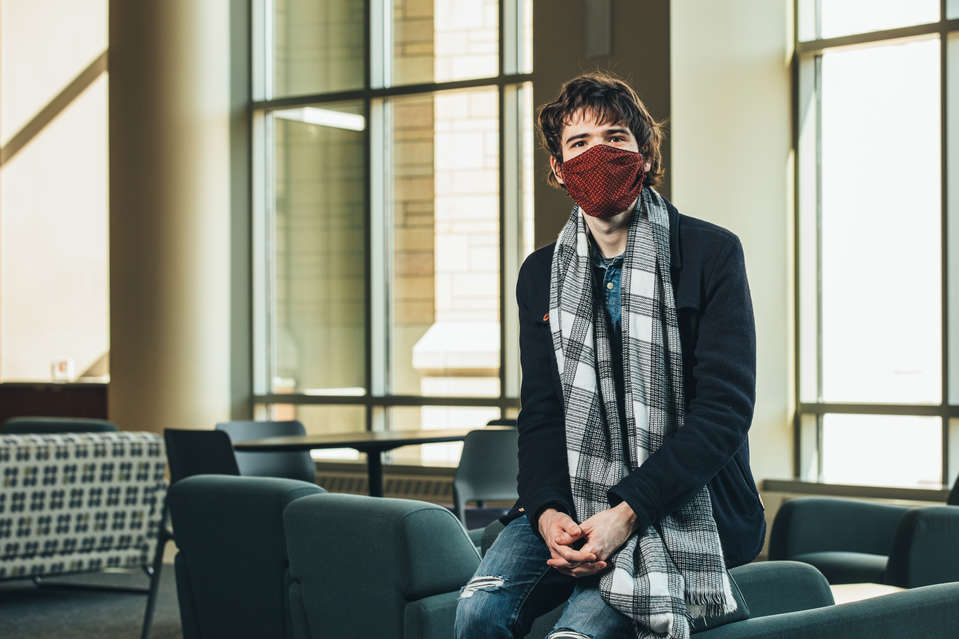
Nicolas Lovichi
Lovichi is adjusting to teaching through Zoom, which he also uses to keep in touch with family and friends. He’s even continuing to produce a podcast about cultural differences.
“We live in a world where we aren’t used to facing challenges like this ... living through dark times like these that push you to do your best in some ways,” he said. “Also, to realize that we cannot live anymore like we did before in some ways. It makes you stronger. Personally, this experience taught me a lot about how to live out of your home country for such a long time in circumstances you didn’t plan. It teaches you how to find a Plan B, Plan C – how to find solutions.”
Sophomore Olivia Tjokrosetio is a psychology and family studies major from Indonesia who is living in Morrison Hall. Like many of her peers, she misses the normalcy of campus life pre-COVID-19.
“I thought I was an introvert, but I guess I'm not,” Tjokrosetio said. “I was loving the first few days of isolation and then after that I needed people to talk to. Thankfully, most of my friends are like that too, so we’ve been Zooming and FaceTiming. That's been fun.”
Sierra Pancoast, mid-campus west block director and graduate student in leadership and student affairs, said her duties have remained the same except meetings,
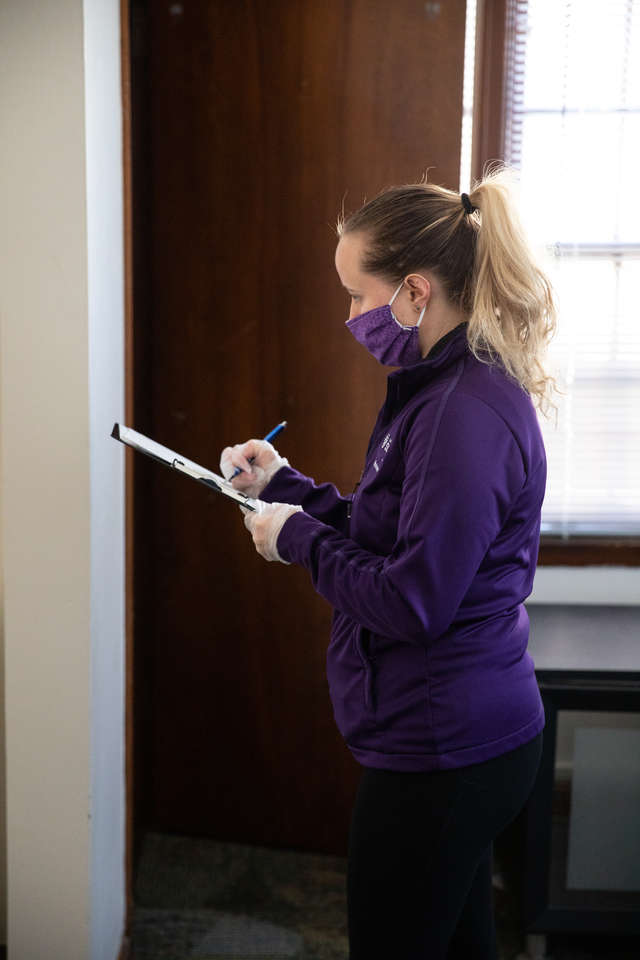
Sierra Pancoast
which are now online. It’s important to remain connected to the students still on campus, she said.
“We've divided up the remaining students among the apartment coordinators in order to contact them individually,” Pancoast said. “They're reaching out and doing a one-on-one conversation with them over Zoom, and if the student wants to talk about things over email, that's fine too. Just a general, ‘Hey, how are you hanging in there?’ If there are any students that are expressing that this is a really difficult time for them, we're able to flag that and respond.”
Pancoast said the experiences she’s had since the pandemic have made her realize she’s resilient and adaptable.
“I'm applying to jobs right now and potential employers are asking things like, ‘How are you handling this?’ Or ‘Tell us about a time you were adaptable?’” Pancoast explained. “I have plenty of examples to share.”
A ‘second family’ with Dining Services
Among his many duties as associate vice president of Auxiliary Services, Mitch Karstens oversees Dining Services. When the switch to online learning occurred and a majority of students moved out of the residence halls, Dining Services went from serving 10,000 meals a day down to 150. Dining locations across the St. Paul and Minneapolis campuses were shuttered. Excess food was given away to the St. Thomas community.
“Usually about two weeks before the end of the semester we stop purchasing and slowly work down our inventory so that we don't waste a lot,” Karstens said. “We hit a cliff this time. We were able to gather everything that was perishable, and we opened that up to the campus community. We gave away about 100 gallons of milk that were in our coffee shops, 250 loaves of bread we would’ve used at dining facilities and a whole host of fresh veggies and fruits. We froze whatever we could.”
Because students remaining in the residence halls and those at the School of Divinity still needed to eat, a central operation set up at T’s where a rotating staff of 15 employees made and prepackaged breakfast, lunch and dinner to go.
“We're trying to use exactly what we have instead of buying more products right now,” Karstens said. “The chefs are getting super creative in the kitchen and making some very good food. It’s not our normal menu.”
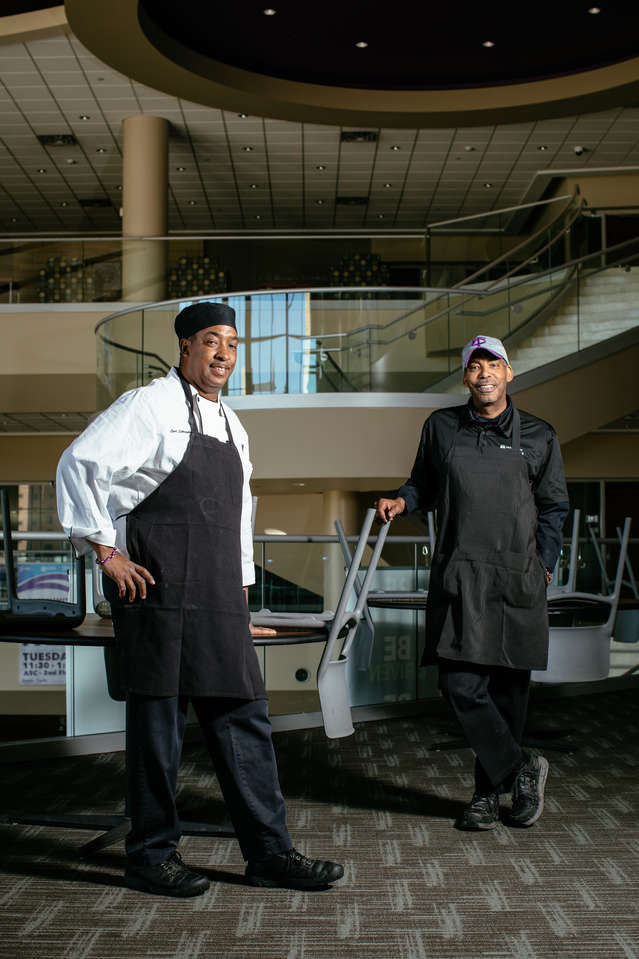
Carl Littlejohn, left, and brother Anthony Littlejohn, right.
“Our dining staff is always putting our students first and thinking about how not getting a meal was going to affect some of our students,” Karstens continued. “That was their biggest concern. It's things like this that remind me how big of a heart they have and how hard they work.”
One of those dedicated employees is Anthony Littlejohn, a manager at The View who has switched to those duties at T’s. He said the international students living on campus have become like a “second family” to him and the staff.
“The Friday before Easter we made sure they had plenty of food for the weekend,” Littlejohn said. “I stayed late, made sure there was extra so they could take all this food back to the residence halls. We try to take care of them the best we can and keep their spirits up. It’s difficult for all of us out here, but it really has to be tough for them not being able to see their family.”
While Littlejohn has adjusted to his current role, he’s looking forward to the time when everyone is back on campus and dining at The View.
“I've gotten to know a lot of students by first name and I've even met some of their families,” he said. “That's probably been the hardest part for me as far as social activity. The students and the football coaches, the basketball coaches – we have great relationships with those folks. I really miss those conversations.”
Stepping up with Public Safety
For Public Safety officer Tyler Vogel, patrols around campus feel a lot different than they have any past semester.
“It’s a quieter feel. It’s peaceful with sunsets, sunrises, very little traffic,” he said. “It’s kind of like we’re forced to have this quiet campus environment when no one wants it to be.”
Despite the quieter nature of their surroundings, work for Vogel and fellow Public Safety officers has actually gotten busier, he said, as fewer people on campus means more ground that needs to be covered for patrols.
“A good chunk of our job is proactive, out patrolling, but most of our job during the school year is reactive,” he said. “Without those eyes and ears of community members everywhere, we’re really ramping up our game that much more to keep it covered.”
That ramping up is part of the overall transition Public Safety has made as it goes from helping 2,800 students and more than 1,000 employees across St. Paul and Minneapolis campuses, to just a couple hundred. There a there are far fewer service calls for things like lockouts, escorts and vehicle jump-starts, said Mike Barrett, associate director of Public Safety.
For Barrett and several other Public Safety employees, part of the transition has been to working from home, where technology allows them to stay connected via
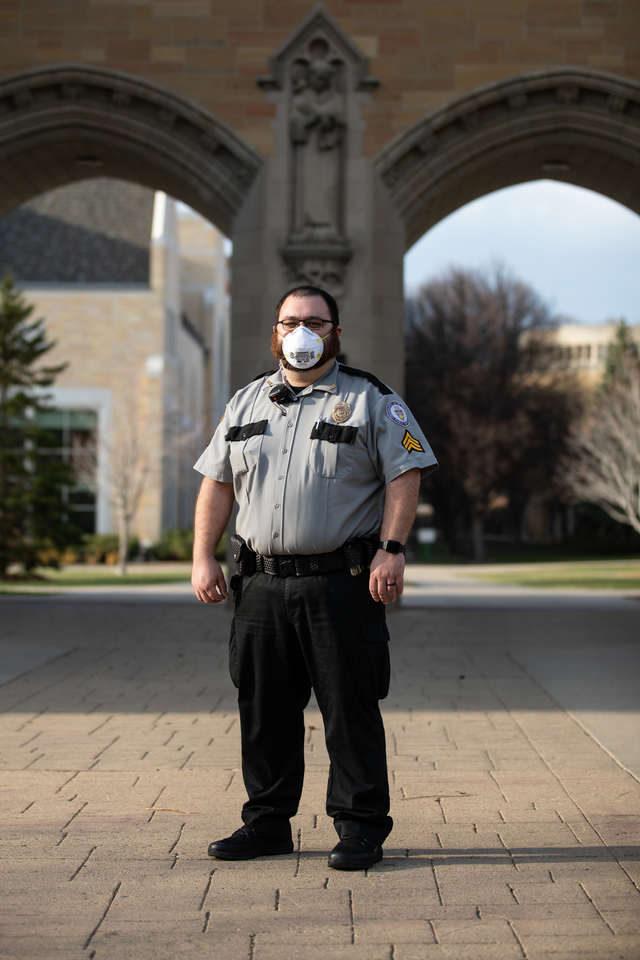
Patrol Sergeant Tyler Vogel.
radio and video to coordinate with on-campus officers. Barrett said his process to manage investigations from home has stayed consistent.
Vogel said he and on-campus colleagues start and end all their shifts at shared workstations and vehicles by wiping down with disinfectants, and everyone can physically maintain social distance within buildings. Staying safe themselves – while keeping the community safe, as well – remains at the heart of what their work looks like.
“Social distancing, per se, is less a problem because so few people are around, but it doesn’t allow us to lower our sense of awareness because we’re walking through sometimes old infrastructure and the door is propped. Was it left open by an officer and it didn’t shut? Or was it forced ajar by someone who wants to find something insecure and take it?” Barrett said. “Moving through those spaces, they can’t let their guards down. Their situational awareness needs to be up on patrol even more so than before.”
Vogel said officers use N95 masks and gloves any time they do have to communicate more closely with someone such as a suspicious person on campus.
“That part of our job doesn’t stop with this,” he said. “We just have to be careful.”
Care is a key word for Public Safety officers as they maintain the department’s mission, which is “dedicated to creating and promoting a safe, secure and peaceful environment.”
“It’s the same as you’ve seen across the country in terms of first responders: Everyone wants to step up and do what’s necessary,” he said. “The moral, the goals, that hasn’t changed. It’s just working within this new norm.”
